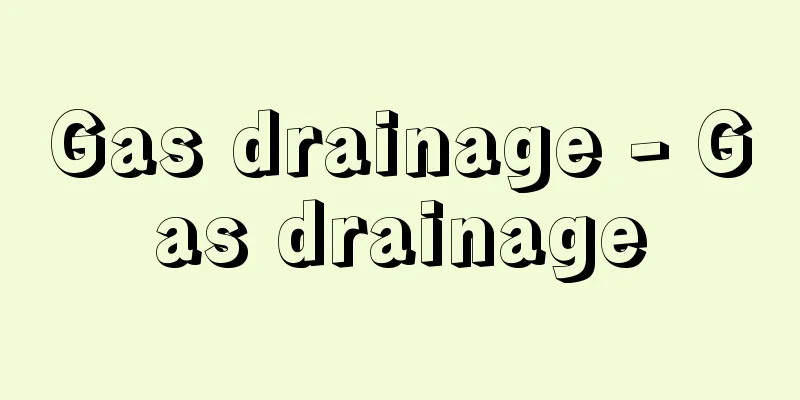Digestion

|
The process of breaking down the nutrients in food into a form that can be absorbed is called digestion. Digestion can be divided into physical digestion and chemical digestion, the former being the movement of the digestive tract, and the latter being the secretion of digestive juices and their digestive action. The group of organs that perform digestion is called the digestive system. [Santa Ichikawa] Digestive systemThe digestive system consists of the digestive tract, which is successively comprised of the oral cavity, pharynx, esophagus, stomach, small intestine, and large intestine, as well as the digestive glands that secrete digestive juices. [Santa Ichikawa] GastrointestinalThe mouth is the entrance to the digestive tract, and the cavity that follows is the oral cavity. Infants have 20 baby teeth, which change to 32 permanent teeth by the age of 12 to 18. The tongue is located at the bottom of the mouth, and has small mucous membrane projections on its surface. Taste buds are located here, and they are responsible for the sense of taste. The oral cavity also contains three salivary glands that secrete saliva: the parotid gland, the submandibular gland, and the sublingual gland. The parotid gland opens into the mucous membrane of the cheek opposite the second molar of the upper jaw, and the other two glands open under the tongue. The pharynx is a complex part that forms the intersection of the digestive system and the respiratory tract, and is about 12 centimeters long, transitioning into the esophagus at the level of the sixth cervical vertebra. The esophagus runs down behind the trachea, passes through the diaphragm and connects to the stomach. It is a tube about 25 centimeters long and narrows in three places: where the esophagus begins, where the trachea splits into the left and right bronchi, and where it passes through the diaphragm. The stomach is a pouch-like organ; the part that enters the stomach from the esophagus is called the cardia, and the wide central part is called the body of the stomach. The part that bulges out above the cardia is called the fundus. The lower part of the stomach is called the pylorus, and it connects to the duodenum. The average stomach capacity for Japanese adults is said to be about 1400cc for males and about 1300cc for females. In newborns, it is 20-60cc. The stomach of an adult is T-shaped or horn-shaped, but in newborns it is in a longitudinal position. The mucosa contains gastric glands that secrete gastric juice. A circular muscle is developed in the pylorus, forming the sphincter. Following the stomach is the small intestine, which is about 7 meters long. It is divided into three parts: the duodenum, jejunum, and ileum. Following the pylorus of the stomach is the C-shaped curved duodenum, which is about 25 to 30 centimeters long, about the length of 12 fingers placed side by side. The pancreatic duct, which carries pancreatic juice from the pancreas, and the common bile duct, which carries bile from the liver and gallbladder, open into the duodenum at the same point. The duodenum is connected to the jejunum via the duodenojejunal ligament, and then to the ileum, but the boundary between the jejunum and ileum is unclear, and the upper half (about two-fifths) is called the jejunum and the lower half (about three-fifths) is called the ileum. The small intestine runs in a winding manner within the abdominal cavity. Duodenal glands are distributed in the duodenal mucosa, and intestinal glands are distributed throughout the small intestine, and they mainly secrete mucus. The small intestine connects to the large intestine in the lower right abdomen. This area is called the ileocecal orifice, where the circular muscle of the ileum thickens and enlarges, and protrudes into the cecal cavity like a lip to form the ileocecal valve, which works to prevent the contents from flowing back into the small intestine. The large intestine is about 1.5 meters long and consists of three parts: the cecum, colon, and rectum. The cecum is a pouch-like part located below where the ileum opens into the large intestine, and has an appendix that is 6 to 8 centimeters long and 6 millimeters in diameter hanging from its tip. From the cecum comes the ascending colon, transverse colon, descending colon, sigmoid colon, and finally the rectum. The wall of the colon is made up of three longitudinal muscles called taenia coli, which shorten the wall vertically. The rectum is located behind the bladder in men and behind the uterus and vagina in women, and opens into the anus. There are internal and external anal sphincters around the anus. Veins are well developed under the mucous membrane of the lower part of the rectum, and when they become lumpy, they form hemorrhoids. [Santa Ichikawa] Digestive glandsThe digestive glands attached to the digestive tract are the liver and pancreas. The liver is located in the upper right part of the abdomen and weighs 1000-1300 grams. It is the center of metabolism, storing nutrients and carbohydrates that come through the portal vein and synthesizing blood proteins, and is also an organ that performs important functions such as hematopoiesis, blood storage, destruction of blood cells, and detoxification. Bile is produced in the liver, passes through the hepatic duct, and is stored in the gallbladder. The hepatic duct joins with the cystic duct coming from the gallbladder to form the common bile duct, which opens into the duodenum. The common bile duct is 6-8 centimeters long, and the gallbladder is 8 centimeters long, 4 centimeters wide, and has a capacity of about 70 cc. The pancreas is a long, thin gland located behind the stomach, about 15 cm long and weighing about 70 grams, and its duct joins the common bile duct and opens into the duodenum. Among the cells that secrete pancreatic juice, there are scattered groups of cells with different shapes, called the islets of Langerhans (pancreatic islets). Hormones such as insulin and glucagon are secreted here. [Santa Ichikawa] Digestion in the mouthFood that enters the mouth is moved between the upper and lower teeth by the movement of the lower jaw and the action of the tongue, cheeks, and lips, and is ground into small pieces. Saliva begins to be secreted in the oral cavity even before food is put into the mouth, that is, even when one thinks about or sees food. During chewing, saliva mixes with the food, giving it a taste and making it easier to swallow. Saliva contains an enzyme called ptyalin, which breaks down carbohydrates. When food is in a state that is easy to swallow, it is swallowed. Some substances are also absorbed through the oral mucosa, but this does not have a significant effect. The act of swallowing is divided into three stages. The first stage is when the food bolus enters the oral cavity and pharynx. This is a voluntary movement that is mainly performed by contraction of the tongue and jaw muscles. The second stage is when the food passes through the pharynx and enters the esophagus. This is a complex involuntary movement that is caused by a reflex via the swallowing center in the medulla oblongata. The food bolus flows into the esophagus after passing through the movement that blocks the gap between the pharynx and the oral cavity, and between the pharynx and the nasal cavity, and the movement that closes the pharynx and the larynx. More than 11 muscles are involved in the second swallowing movement. The third stage is when food passes through the esophagus. Food is transported by peristalsis that occurs at the entrance to the esophagus. The upper part of the esophagus is made of skeletal muscle, and the lower part is made of smooth muscle, but the speed of peristalsis is faster in the upper part. The vagus nerve is involved in this movement. The lower part of the esophagus does not have a sphincter, but the internal pressure is higher than that of the stomach, so food in the stomach does not reflux. However, when swallowing begins, the internal pressure in this part decreases, making it easier for food to flow into the stomach. Since food is transported by peristalsis in the esophagus, even if you stand upside down or are in zero gravity, swallowed food will be sent to the stomach. [Santa Ichikawa] Digestion in the stomachThe stomach wall is made up of three muscle layers: longitudinal, circular, and oblique muscles, and the inner surface is covered with a mucous membrane with many folds. When the stomach is empty, the front and rear walls are in contact with each other and there are no gaps. However, when food enters the stomach, it is piled up in layers in the body of the stomach in the order in which it entered. When food enters, a constriction appears near the cardia, and the constriction moves toward the pylorus. This is called a peristaltic wave. Peristalsis is a weak constriction in the body of the stomach, but it becomes large and strong near the pylorus. It takes 10 to 40 seconds for food to move from the cardia to the pylorus. The circular muscles in the pylorus are particularly enlarged, forming the pyloric sphincter, and when food reaches the pylorus, most of the contents flow back into the body of the stomach because of this sphincter. As this process is repeated, the contents are sufficiently mixed with gastric juice and become like gruel. The food then travels little by little to the duodenum, and usually 80% of the food is expelled from the stomach within 2 to 3 hours. Gastric motility is stimulated by the vagus nerve and inhibited by the sympathetic nerve, as well as regulated by chemicals secreted from the mucous membranes of the stomach and small intestine. The stomach mucosa contains many secretory glands that secrete hydrochloric acid, an enzyme called pepsinogen, and mucus. These are collectively called gastric juice. Hydrochloric acid activates pepsinogen to turn it into pepsin, and pepsin breaks down proteins into polypeptides. Hydrochloric acid also swells proteins to make them easier for enzymes to work on, and plays an important role in protein digestion. Hydrochloric acid also breaks down sucrose and kills acid-sensitive bacteria that enter the stomach with food. Mucus protects the stomach mucosa and neutralizes acid. Gastric juice also contains rennet and lipolytic enzymes. Gastric juices, which have this effect, are secreted when we think about, see, or smell food, but they are secreted in the greatest quantity when food enters the stomach. Secretion is promoted by the vagus nerve, and is regulated by gastrin and gastric inhibitory polypeptides secreted from the digestive tract. Emotions also greatly affect gastric juice secretion. This is well-proven by the following observation reported in 1833. In a Canadian patient with a gunshot wound, the stomach mucosa was found to become congested and gastric juice secretion increased when the patient was angry or hostile, while fear suppressed the secretion. Other gastric juice secretions are also stimulated by alcohol, caffeine, meat extracts, etc. When a patient has a gastric ulcer, they are advised to refrain from alcohol, coffee, and meat, and to train themselves to reduce mental agitation in order to suppress gastric juice secretion and to minimize irritation to the stomach wall. The stomach does not absorb any nutrients, but does absorb alcohol and glucose to a small extent. Vomiting occurs when the gastric mucosa is irritated (for example, due to stomach cancer, stomach ulcers, acute gastritis, etc.), as well as in cases of cholelithiasis, appendicitis, intussusception, increased intracranial pressure, car sickness, and morning sickness. When observing stomach movement during vomiting, a phenomenon is observed in which peristaltic waves are generated from the pylorus and move toward the cardia (this is called reverse peristalsis). In addition, when vomiting, the abdominal muscles contract to increase abdominal pressure, and this action also helps expel the contents. [Santa Ichikawa] Digestion in the Small IntestineIn the small intestine, the food sent from the stomach in the form of porridge is further broken down by intestinal movement and digestive juices, and nutrients are absorbed. [Santa Ichikawa] Small intestinal motility and regulationThere are two types of small intestinal movement: local contractions and propagating contractions. Local contractions are called segmental movements, in which constrictions appear in several places in the small intestine and then disappear. Then, new constrictions appear in other places and then disappear again. This type of movement is called segmental movement, which is repeated about every 5 seconds throughout the intestine at intervals of 0.5 to 1 centimeter. This mechanically segments the contents into small pieces and mixes them with digestive juices. Propagating contractions are called peristalsis, in which constrictions are transmitted from the mouth to the anus, and play a role in transporting the contents. It is said that peristalsis occurs 12 times per minute in the human jejunum, 10 times in the ileum, 21 times per minute in the dog duodenum, 17 times in the jejunum, and 8 to 12 times in the ileum. The propagation speed is 8-22 cm per minute in the duodenum, 1.8 cm per minute in the jejunum, and 0.2-0.7 cm per minute in the ileum in dogs. These data indicate that the upper part of the small intestine is more active than the lower part. When the intestinal wall mucosa is stimulated chemically or mechanically, the excitation is transmitted from the submucosal nerve plexus (Meissner's plexus) in the intestinal wall to the myenteric plexus (Auerbach's plexus), which sends an excitation signal to the muscles on the oral side of the intestine and an inhibition signal to the anal side. As a result, the oral side contracts and the anal side relaxes. The contents are transported from the oral side to the anal side by this peristaltic wave. The nerve plexus mentioned above is responsible for this direction, and it is known that these intramural nerve plexuses lose their directionality when anesthetized with cocaine or other drugs. Peristaltic waves do not propagate continuously throughout the entire length of the intestinal tract, but stop when they have propagated to a certain length, and new peristaltic waves are generated and propagated from there. Nerves and hormones regulate the movement of the small intestine. The regulation by nerves is performed by the autonomic nerves, with the sympathetic nerves mainly suppressing movement and the vagus nerves promoting it. This action is performed through chemical substances called noradrenaline secreted from the sympathetic nerve terminals and acetylcholine secreted from the vagus nerve terminals. Therefore, the same effect can be obtained by directly acting these substances on the intestine. In addition, it is known that there are nerves in the intramural nerve plexus that regulate intestinal movement by secreting adenosine triphosphate (ATP), serotonin, histamine, etc. from their terminals. In addition, there is also regulation by reflexes related to other organs via the autonomic nerves. This is called extraintestinal reflexes, and for example, when the small intestine pressure increases, the large intestine movement is suppressed, when the stomach pressure increases, the ileum movement is activated, and intestinal movement is suppressed or promoted by stimuli from other organs such as the bladder. Hormonal regulation is carried out by numerous gastrointestinal hormones secreted from the gastrointestinal mucosa. Of these, cholecystokinin-pancreozymin (CCK-PZ) and gastrin secreted from the duodenum promote small intestinal motility, while secretin inhibits it. In addition, when you are hungry, a hormone called motilin is secreted from the intestine, which induces large peristaltic waves. In this way, motility is also delicately regulated by gastrointestinal hormones. [Santa Ichikawa] Secretion of digestive juices and digestion/absorptionIn addition to the intestinal juices secreted from the jejunum and ileum, the small intestine also receives bile and pancreatic juices from the common bile duct and pancreatic duct, which open into the duodenum. Bile contains bile salts such as glucocolic acid and taurocholic acid. These bile salts emulsify fats, turning them into small lipid droplets that facilitate the action of the digestive enzyme lipase in the pancreatic juice. Pancreatic juice contains many digestive enzymes. The proteolytic enzymes trypsin and chymotrypsin are secreted from the pancreas as trypsinogen and chymotrypsin, respectively, but are converted to trypsin and chymotrypsin by enteropeptidase (enterokinase) in duodenal juice and by trypsin secreted from the pancreas and activated. The peptide-cleavage process (decomposition into polypeptides) of proteins, which was started by pepsin in the gastric juice, continues in the intestine, turning them into dipeptides. Pancreatic lipase, a fat-decomposing enzyme, breaks down triglycerides into monoglycerides and fatty acids, and amylase, a carbohydrate-decomposing enzyme, breaks down starch, glycogen, etc. into maltose, just like amylase in saliva. In this way, food is broken down by the action of pancreatic juice and bile, but it is not yet complete, and digestion is completed by adding the decomposition enzymes contained in the intestinal juice. The small intestinal mucosa contains secretory glands that secrete mucus, but the digestive enzymes in the small intestinal juice are not only secreted from these glands, but also contain many digestive enzymes in the epithelial cells of the villi. In epithelial cells, digestion is carried out by the cells themselves, but when the cells are destroyed, the enzymes contained in them are released into the intestinal juice and the digestive action is carried out again. About 30% of epithelial cells are destroyed every day and replaced with new ones. Digestion is completed by these digestive enzymes in the intestinal juice. In other words, carbohydrates are broken down into monosaccharides, such as lactose into glucose and galactose by lactase in the intestinal juice, maltase into maltose into glucose, and sucrase into sucrose into glucose and fructose. Proteins that have been broken down into dipeptides are further broken down into amino acids by dipeptidase in the intestinal juice. These decomposition products are also absorbed in the small intestine, either passively due to the concentration difference between the cells and the intestinal lumen, or by the pump mechanism in the mucosal cells of the small intestine, or by phagocytosis and pinocytosis of the cells. Absorption takes place in the mucosa of the small intestine, which has about 30 villi per square millimeter, and the cells on its surface are covered with microvilli, so the absorption area of the small intestine is as large as 200 square meters. However, when considering digestion and absorption, it is difficult to distinguish where digestion ends and absorption begins. This is because absorption takes place through the microvilli membrane, but the microvilli membrane also contains decomposition enzymes, and digestion takes place at the same time as absorption (this is called membrane digestion). Although extremely rare, there are cases where some of the membrane enzymes are congenitally missing. For example, if lactase is missing, lactose is not fully absorbed, resulting in diarrhea and nutritional disorders. In such cases, carbohydrates other than lactose must be supplemented. Also, while proteins are normally absorbed in the form of amino acids, they can sometimes be absorbed as polypeptides or proteins. In these cases, these act as antigens, causing antibodies to form in the plasma, which then triggers allergies. An example of this is the rash caused by eating egg whites, fish, etc. The absorbed nutrients pass from the cells into the capillaries and lymphatic vessels distributed in the center of the villi, and are stored in the liver through the portal vein, but some are distributed to each tissue for use. Most of the water and electrolytes are also absorbed in the small intestine. [Santa Ichikawa] Digestion in the large intestineThe contents of the large intestine are sent via the ileum approximately every 30 seconds. It is said that it takes 4 to 15 hours for food to enter the large intestine from the mouth, depending on the type of food. The large intestine also exhibits segmental movement, peristalsis, and reverse peristalsis, and the contents move toward the anus by repeating gentle reciprocating movements. The large intestine is mainly responsible for the absorption of water. When food enters the stomach, a gastro-colic facilitatory reflex occurs, and strong contractions known as total peristalsis occur every 2 to 4 minutes, sending the contents of the large intestine all at once to the sigmoid colon and rectum. The movement of the large intestine is also controlled by the autonomic nervous system, with the sympathetic nervous system acting as an inhibitor and the parasympathetic nervous system acting as an inhibitor. In addition, reflexes occur between the stomach, small intestine, bladder, etc., just as in the case of the small intestine. Hormones also regulate movement, but the details are not yet known. The large intestine secretes alkaline mucus, which contains almost no digestive enzymes and whose role is to protect the wall of the large intestine. There is no enzyme digestion in the large intestine, but more than 100 types of bacteria, including E. coli and Myxobacterium, are always present, breaking down fiber, destroying cell membranes, and fermenting. Intestinal gas is also produced by fermentation and the decay of protein, which stimulates the intestinal tract and promotes the movement of the large intestine. The mucous membrane of the large intestine has the ability to absorb water and salts. This absorption ability is used to insert anesthetics and painkillers into the rectum as suppositories. When contents enter the rectum, the urge to defecate arises, and the defecation center in the sacral spinal cord reflexively increases rectal peristalsis and relaxes the internal and external anal sphincters, resulting in defecation. Defecation is achieved by contraction of the sigmoid colon and rectum and increased abdominal pressure, but the levator ani contracts to prevent the rectum from escaping. Although it depends on the type of food, it is said that on average after a meal, contents reach the transverse colon 6 hours after a meal, the descending colon 9 hours after a meal, and the sigmoid colon 12 hours after a meal. [Santa Ichikawa] Digestion in animalsDigestion is the process by which animals absorb the substances they take in as food and change them into a form that is useful as nutrients, and in many cases involves breaking down high molecular weight compounds into low molecular weight compounds. In protozoa and lower animals, intracellular digestion occurs, with food being taken in by food vacuoles and digested by enzymes such as lysosomes. In most animals, digestion occurs in the digestive tract, the structure and function of which are extremely diverse depending on the diet, as follows: (1) Herbivorous animals Polysaccharides such as cellulose are often digested by symbiotic bacteria in the digestive tract. In ruminants, symbiotic bacteria reside in the first to third stomachs, and only the fourth stomach secretes digestive enzymes. Herbivorous mollusks and echinoderms have unique organs, such as the radula and Aristotle's lantern, for chewing seaweed, and mollusks secrete several enzymes that break down plant polysaccharides. In herbivorous insects, digestion occurs in the midgut, which is connected to the gizzard used for chewing, by digestive enzymes from the midgut gland. Wood-eating bark beetles (isopods) break down many polysaccharides. (2) Sediment-feeding animals Earthworms feed on sediments such as subsoil, crushing the soil and sand in their gizzards and digesting the organic matter in their intestines. Earthworm droppings contain more calcium and phosphate than soil, and the soil improvement provided by earthworms is useful for pasture grass, etc. (3) Carnivores Coelenterates digest prey captured by nematocysts in the tentacles in the coelenteron. Echinoderms such as starfish press their stomachs upside down onto bivalve shellfish and inject proteolytic enzymes to digest them. Cephalopods paralyze their prey with toxins in their salivary glands, preliminarily digest it in their stomachs, and then digest it with proteolytic and amylases in the midgut gland. Crustaceans such as crayfish have powerful chewing apparatus in their stomachs and digest food in a digestive ceca. (4) Filter feeders Sessile marine invertebrates have a special device for filtering out suspended matter. Ascidians collect particles on the mucus produced by the glandular cells of the endostyle, and excrete excess water through the respiratory spiracles. Bryozoans and mollusks (such as oysters) have rapidly rotating rods in their digestive tracts that capture particles on the mucus and send them to the area where digestion occurs. The rotating rods of mollusks are made of mucoprotein and are called crystalloids. (5) Liquid-feeding animals The stomach of a honeybee is called the nectar stomach and has a filtering device that filters pollen from nectar to produce honey. Blood-sucking mites and other animals secrete anticoagulants from their salivary glands, and spiders spray their prey with saliva containing powerful proteolytic enzymes to digest it. Leeches store up to 10 times their usual volume of blood in their stomachs, and it takes several weeks or months for them to hemolyze and digest the blood. [Sadao Yasugi] "Chiba Collection: Digestive System" by F.H. Netter, translated by Kaito Isamu et al., 3 volumes (1978-1979, Ciba-Geigy Japan)" ▽ "Fundamentals and Clinical Practice of Gastrointestinal and Intestinal Motility" by Zeniba Takehiko (1979, Shinko Trading Medical Book Publishing Division)" ▽ "The Digestive Tract" by J. Morton, translated by Yasugi Sadao (1980, Asakura Shoten)" ▽ "Digestive System Terminology Dictionary - Esophagus, Stomach, and Intestines, edited by Sato Nobuhiro, and edited by Kawano Jun and Miwa Hiroto, new revised edition (1999, Medical Review Co., Ltd.)" ▽ "Medical Physiology Outlook" by W.F. Ganong, translated by Okada Yasunobu, Akasu Takashi, Ueda Yoichi et al., 20th original edition (2002, Maruzen)" ▽ "Digestive System Terminology Dictionary - Liver, Gallbladder, and Pancreas" by Takei Nobuyuki and Sato Nobuhiro (2004, Medical Review Co., Ltd.) " ▽ "Clinical Gastroenterology" edited by Ishii Hiromasa et al. (2005/Popular Edition, 2012, Asakura Shoten)" ▽ "Digestive System" edited by Uenishi Norio et al. (2005, Medical View Co., Ltd.) [Reference items] | | | | | | |©Shogakukan "> Names of the Digestive System ©Shogakukan "> Animal digestive tract Source: Shogakukan Encyclopedia Nipponica About Encyclopedia Nipponica Information | Legend |
|
食物中の栄養素を吸収できる形に分解する過程を消化という。消化の方法は、物理的消化と化学的消化に分けられるが、前者は消化管の運動であり、後者は消化液の分泌と、その消化作用である。また、消化を行う器官の集まりを消化器系という。 [市河三太] 消化器系消化器系は、口腔(こうくう)、咽頭(いんとう)、食道、胃、小腸、大腸の順に連続している消化管と、消化液を分泌する消化腺(せん)とからなっている。 [市河三太] 消化管消化管の入口は口であるが、これに続く腔が口腔である。口腔内にあるそしゃく器官としての歯は、幼児にあっては20本の乳歯であるが、12~18歳ころまでには32本の永久歯に変わる。口腔底には舌があり、その表面には小さな粘膜突起がある。ここには味蕾(みらい)があり、味の感覚をつかさどっている。また、口腔領域には、唾液(だえき)を分泌する唾液腺があるが、これは、耳下腺(じかせん)、顎下腺(がくかせん)、舌下腺(ぜっかせん)の3種類があり、耳下腺は上顎の第二大臼歯(だいきゅうし)に向かい合う頬(ほお)の粘膜に開口し、他の2腺は舌下に開口している。咽頭は消化器と気道の交叉(こうさ)部を形づくる複雑な部分で、長さは約12センチメートルであり、第6頸椎(けいつい)の高さで食道に移行する。食道は気管の後ろを下り、横隔膜を貫いて胃と連絡している。長さ約25センチメートルの管で、食道の始まるところ、気管が左右の気管支に分かれるところ、横隔膜を貫くところの3か所で狭くなっている。 胃は嚢(のう)状の器官で、食道から胃に入るところを噴門部、中央の広い部分を胃体という。そのうち噴門部の上方に膨らんで出ている部分を胃底という。胃の下方は幽門部とよび、十二指腸につながる。胃の容量平均は、日本人の成人の場合、男性ではおよそ1400cc、女性ではおよそ1300ccといわれる。なお、新生児では20~60ccである。成人の胃は丁字形または牛角に近い形をしているが、新生児では縦位である。粘膜には胃液を分泌する胃腺がある。幽門部には、輪状に走る筋が発達していて、括約部を形づくっている。 胃に続いて約7メートルの長さをもつ小腸がある。小腸は十二指腸、空腸、回腸の3部に分けられる。胃の幽門に続いてまず、C字形に彎曲(わんきょく)した十二指腸があるが、これは指を12本横に並べたくらいの長さで約25~30センチメートルである。十二指腸内には、膵臓(すいぞう)から膵液を送る膵管と、肝臓・胆嚢(たんのう)から胆汁を送る総胆管が、同じ箇所で開口している。十二指腸は、十二指腸空腸靭帯(じんたい)を境として、空腸につながり、さらに回腸に至るが、空腸と回腸の境界は明らかでなく、上半(約5分の2)を空腸、下半(約5分の3)を回腸といっている。小腸は腹腔内を曲がりくねって走っている。十二指腸粘膜には十二指腸腺、小腸全体には腸腺が分布しており、おもに粘液を分泌している。小腸は右下腹部で大腸に連絡する。この部は回盲口といい、回腸の輪走筋が厚く肥大するほか、唇のように盲腸腔内に突出して回盲弁を形成し、内容物が小腸へ逆流しないように働いている。 大腸の長さは約1.5メートルであり、盲腸、結腸、直腸の3部からなる。盲腸は回腸が大腸に開いたところより下方にある袋状の部分で、先端に長さ6~8センチメートル、直径6ミリメートルほどの虫垂が垂れ下がっている。盲腸から上行結腸、横行結腸、下行結腸、S状結腸と順に続き、最後に直腸につながる。結腸の壁には縦に走る3本の縦走筋でできた結腸ヒモ(紐)があり、結腸壁を縦に縮めている。直腸は男性では膀胱(ぼうこう)の後方、女性では子宮、腟(ちつ)の後方にあり、肛門(こうもん)に開いている。肛門の周囲には内・外肛門括約筋がある。なお、直腸の下部の粘膜下には静脈がよく発達しており、これが瘤(こぶ)状になると痔核(じかく)をつくる。 [市河三太] 消化腺消化管に付属する消化腺には、肝臓と膵臓がある。肝臓は腹部の右上部にあり、1000~1300グラムの重さがある。門脈を通ってくる養分や糖質の貯蔵、血液タンパク質の合成など物質代謝の中心であるとともに、造血作用、血液の貯蔵、血球の破壊、解毒作用などの重要な働きをする器官である。肝臓では胆汁が生成され、肝管を通って肝臓外に出て胆嚢に蓄えられる。肝管は胆嚢からくる胆嚢管と合して総胆管となり、十二指腸内に開いている。総胆管の長さは6~8センチメートル、胆嚢の大きさは長さ8センチメートル、幅4センチメートル、内容量は70cc程度である。 膵臓は胃の後方にある長さ約15センチメートル、重さ約70グラムの細長い腺で、導管は総胆管と合流して十二指腸に開いている。膵液を分泌する細胞群のところどころには異なった形の細胞群が点在し、これをランゲルハンス島(膵島)とよんでいる。ここではインスリンinsulin、グルカゴンglucagonなどのホルモンが内分泌される。 [市河三太] 口腔での消化口から入った食物は下顎の運動、および舌、頬、口唇の働きで上下の歯列の間に移動され、すり合わされて細かく砕かれる。口腔内で分泌される唾液は、食物を口に入れる前から、すなわち、食物のことを考えたり見たりするだけでも分泌が始まるもので、そしゃく時にあっては、食物と混じり合って味覚を感じさせ、食物を飲み込みやすい形にする。唾液中にはプチアリンptyalinという酵素があり、糖質の分解が行われる。食物が飲み込みやすい状態になったら嚥下(えんげ)が行われる。なお、口腔粘膜からも、ある程度の物質の吸収が行われるが、重要な意味はもっていない。嚥下という動作は三つの過程に分けられる。第1期は食塊が口腔から咽頭に入るまでの時期で、これは、おもに舌やあごの筋が収縮することによって行われる随意運動である。第2期は咽頭を通過して食道に入るまでの時期で、これは、延髄にある嚥下中枢を介しての反射によるもので、複雑な不随意運動である。咽頭と口腔の間、および咽頭と鼻腔の間を遮断する運動、咽頭と喉頭(こうとう)を閉鎖する運動を経て食塊は食道へ流入する。第2期の嚥下運動には11個以上の筋が関与している。第3期は食物が食道を通過する時期である。食物は食道の入口からおこった蠕動(ぜんどう)によって運ばれる。食道は上部は骨格筋、下部は平滑筋よりなるが、蠕動の進行速度は上部のほうが速い。この運動には迷走神経が関与している。食道の下部は、括約筋はないが内圧が胃より高いため、胃の中の食物は逆流しない。しかし、嚥下が始まるとこの部の内圧は低くなるため、胃内への食物の流入はたやすくなる。なお、食道では蠕動によって食物が運ばれるため、逆立ちをしても、また無重力のところにいても、飲み込んだ食物は胃に送られる。 [市河三太] 胃における消化胃壁は縦走筋、輪走筋、斜走筋の三つの筋層から成り立っており、内面はひだの多い粘膜で覆われている。胃が空虚なときは前後の壁は相接していてすきまはない。しかし、胃に食物が入ってくると、食物は入った順序に従って胃体部に層状に重積する。食物が入ると噴門部付近からくびれが生じ、くびれは幽門部へ向かって移動する。これを蠕動波という。蠕動は胃体部では弱いくびれであるが、幽門部近くになると大きくて強いくびれとなる。食物が噴門部から幽門部まで進むのには10~40秒かかる。幽門部は輪走筋がとくに肥大して幽門括約部を形づくっており、幽門部に食物がくるとこの括約部のため、大部分の内容物は胃体のほうに逆流する。このことを繰り返しているうちに、内容物は胃液と十分混和されて粥(かゆ)のような状態になる。そして少量ずつ十二指腸のほうへ移動していき、通常2~3時間で食物の80%は胃から排出される。胃のこうした運動は、迷走神経によって盛んになり、交感神経によって抑制されるほか、胃や小腸の粘膜から分泌される化学物質によっても調節されている。 胃の粘膜には多くの分泌腺があり、塩酸、ペプシノゲンpepsinogenとよばれる酵素、粘液を分泌している。これらをあわせて胃液という。塩酸はペプシノゲンを活性化してペプシンpepsinにし、ペプシンはタンパク質をポリペプチドpolypeptideに分解する。また、塩酸にはタンパク質を膨化させて酵素が働きやすくなるようにする作用があり、タンパク質消化に重要な役割を果たしている。塩酸はこのほか、ショ糖を分解したり、さらに食物とともに入ってきた酸に弱い細菌を殺す作用ももっている。粘液は胃の粘膜を保護し、酸を中和する働きをもっている。なお、胃液には凝乳酵素や脂肪分解酵素も含まれている。 このような作用をもつ胃液は、食物のことを考えたり、見たり、香りによる刺激だけでも分泌されるが、食物が胃の中に入ってきたときに、もっとも多量に分泌される。分泌は迷走神経によって促進されるほか、消化管から分泌されるガストリンgastrinや胃抑制ポリペプチドなどによって調節されている。また、感情の動きによっても胃液分泌は大いに影響を受ける。このことは、1833年に報告された次の観察によってよく証明される。すなわち、銃創のために胃に穴のあいたカナダ人患者の胃内部を観察した際、怒ったり敵意をおこしたりすると胃粘膜が充血して胃液分泌が盛んになり、逆に恐怖心をおこすと抑制されるという結果が出たというものである。このほかアルコール、カフェイン、肉エキスなどによっても胃液分泌は盛んになる。胃潰瘍(いかいよう)があるとき、アルコールやコーヒー、肉類を控えさせ、精神的動揺を少なくするように自己訓練させるのは、胃液の分泌を抑えて、胃壁になるべく刺激を与えないようにするためである。胃では養分の吸収はほとんど行われないが、アルコールやブドウ糖はわずかに吸収される。 嘔吐(おうと)は、胃粘膜に刺激が加えられたとき(たとえば胃がん、胃潰瘍、急性胃炎など)、また胆石症、虫垂炎、腸重積のとき、脳の内圧が高まったり、車酔いなどのとき、さらに妊娠悪阻(おそ)(つわり)のときなどにおこる。嘔吐の状態での胃の運動をみると、平常とは逆に幽門部から蠕動波が発生し、噴門部のほうへ進む現象が認められる(これを逆蠕動という)。また、嘔吐の際には、腹筋が収縮して腹圧を高め、内容物の排出を助ける動作も加わってくる。 [市河三太] 小腸における消化小腸では、粥状になって胃から送られた食物を、小腸運動と消化液によってさらに分解し、養分の吸収が行われる。 [市河三太] 小腸の運動と調節小腸の運動には、局所収縮と伝播性(でんぱせい)収縮とがある。局所収縮は分節運動といわれるもので、小腸の数か所にくびれが生じ、やがて消失する。すると、次には他の部位に新しいくびれができて、また消失する。このような運動が0.5~1センチメートルの間隔で腸の全体にわたり、約5秒ごとに繰り返されるのが分節運動である。これにより、内容物は機械的に小さく分節され、消化液と混和される。伝播性収縮は蠕動といわれるもので、くびれが口側から肛門側へ向かって伝わる運動で、内容物の運搬の役割を果たす。ヒトの空腸では1分間に12回、回腸では10回、イヌの十二指腸では1分間に21回、空腸で17回、回腸で8~12回ほどの蠕動がおこるといわれている。また、伝播速度は1分間にイヌの十二指腸で8~22センチメートル、空腸で1.8センチメートル、回腸で0.2~0.7センチメートルとされる。このデータから、小腸上部のほうが下部に比べて運動が活発であることがわかる。 腸壁粘膜を化学的に、または機械的に刺激すると、その興奮は腸壁にある粘膜下神経叢(そう)(マイスネル神経叢)から筋間神経叢(アウエルバッハ神経叢)に伝わり、そこから腸管の口側の筋肉には興奮、肛門側には抑制の信号が送られる。その結果、口側は収縮し、肛門側は弛緩(しかん)する。内容物はこの蠕動波によって、口側から肛門側に運ばれていく。このような方向づけを行うのが先に述べた神経叢で、これらの壁内神経叢をコカインなどで麻酔すると、方向性をなくしてしまうことが知られている。蠕動波は、腸管の全長にわたって間断なく伝播するわけではなく、一定の長さまで伝わるとそこで止まり、また新しい蠕動波がそこから生じて伝播していく。 このような小腸の運動の調節をしているのは、神経とホルモンである。神経による調節は自律神経によって行われ、主として交感神経が運動を抑制し、迷走神経が促進する。この作用は、交感神経末端から分泌されるノルアドレナリンnoradrenalin、迷走神経末端からのアセチルコリンacetylcholinという化学物質を介して行われる。したがってこれらの物質を腸管に直接作用させても、同様の効果が得られる。またこのほか壁内神経叢には、アデノシン三リン酸(ATP)、セロトニンserotonin、ヒスタミンhistamineなどを末端から分泌して腸管運動を調節している神経のあることがわかっている。このほか、自律神経を介して、他の臓器に関連した反射による調節もある。これは腸外反射とよばれるもので、たとえば小腸内圧が高くなると大腸運動が抑制されたり、胃の内圧が高くなると回腸運動が盛んになったり、膀胱など他の臓器からの刺激によって腸の運動が抑制されたり促進されたりするというものである。 ホルモンによる調節は、消化管粘膜から分泌される数多くの消化管ホルモンが行っている。そのうち、十二指腸から分泌されるコレシストキニン・パンクレオチミン(CCK‐PZ)やガストリンは小腸運動を亢進(こうしん)させ、セクレチンsecretinは抑制する。また、空腹時には腸管からモチリンmotilinというホルモンが分泌され、大きい蠕動波の群れを引き起こさせる。このように消化管ホルモンによっても、運動は微妙に調節されている。 [市河三太] 消化液の分泌と消化・吸収小腸における消化液は、小腸内で分泌される腸液(空腸、回腸から分泌される液)のほかに、十二指腸には総胆管と膵管が開口して胆汁や膵液が流入している。胆汁にはグルココール酸やタウロコール酸など胆汁酸塩類が含まれている。これらの胆汁酸塩類は脂肪を乳化し、小さな脂肪滴にして、膵液の消化酵素リパーゼlipaseが作用しやすいように働く。膵液の中には多くの消化酵素が含まれている。タンパク質分解酵素のトリプシンtrypsinはトリプシノーゲンtrypsinogenとして、キモトリプシンchymotrypsinはキモトリプシノーゲンchymotrypsinogenとして膵臓から分泌されるが、十二指腸液中のエンテロペプチダーゼenteropeptidase(エンテロキナーゼenterokinase)や膵臓から分泌されて活性をもったトリプシンによってそれぞれトリプシン、キモトリプシンとなる。タンパク質は胃液中のペプシンによって始められたペプチド切断作業(ポリペプチドへの分解)が腸内でも続けられ、ジペプチドdipeptideになる。脂肪分解酵素の膵リパーゼpancreatic lipaseはトリグリセリドtriglycerideをモノグリセリドmonoglycerideと脂肪酸に分解し、糖質分解酵素であるアミラーゼamylaseは唾液中のアミラーゼと同様に、デンプン、グリコーゲンなどを麦芽糖に分解する。このように膵液や胆汁の働きによって食物は分解されていくが、まだ完全ではなく、これに腸液中に含まれる分解酵素が加わって消化は完全なものとなる。小腸粘膜には分泌腺があり、粘液を分泌するが、小腸液中の消化酵素はここからだけ分泌されるのではなく、絨毛(じゅうもう)の上皮細胞にも多くの消化酵素が含まれている。上皮細胞では、細胞自体でも消化が行われるが、細胞が破壊される際にも、これに含まれる酵素が腸液中に放出されて、ふたたび消化作用を行うこととなる。上皮細胞では約30%が毎日壊されて新しいものと交代している。こうした腸液中の消化酵素によって消化は完了していくわけである。つまり、腸液中のラクターゼlactaseは乳糖をブドウ糖とガラクトースgalactoseに、マルターゼmaltaseは麦芽糖をブドウ糖に、スクラーゼsucraseはショ糖をブドウ糖と果糖にというように、糖質は単糖類に分解される。また、タンパク質は、ジペプチドにまで分解されていたものをさらに、腸液中のジペプチダーゼdipeptidaseによってアミノ酸に分解される。 小腸ではこれらの分解産物の吸収も行われ、細胞内と腸管腔内の濃度差により受動的に吸収されたり、あるいは小腸の粘膜細胞にあるポンプ機構によって吸収されるほか、細胞のもつ食作用および飲作用などによっても吸収される。吸収は小腸の粘膜で行われるが、ここには1平方ミリメートルに約30個の絨毛があり、その表面の細胞は微絨毛で覆われているため、小腸の吸収面積は200平方メートルにも及ぶ面積となる。しかし、消化と吸収について考えた場合、どこまでが消化で、どこからが吸収かという区別をつけることはむずかしい。なぜなら、吸収は微絨毛膜を通して行われるが、微絨毛膜にも分解酵素が存在しており、この細胞膜では吸収と同時に消化も行われているからである(このことを膜消化という)。 なお、きわめてまれではあるが、先天的に膜の酵素の一部が欠けている場合がある。たとえば、ラクターゼが欠けていると、乳糖の吸収が不完全となり、下痢や栄養障害をおこすこととなる。このような場合には、乳糖以外の糖質を補わなくてはならない。また、タンパク質は普通アミノ酸の形で吸収されるが、ポリペプチドやタンパク質のままで吸収されることがある。この場合は、これらが抗原となって血漿(けっしょう)中に抗体ができ、アレルギーを引き起こすことになる。卵の白身、魚などによって発疹(ほっしん)をおこすのはこの例である。 吸収された栄養素は、細胞から絨毛の中心に分布している毛細血管やリンパ管の中に入り、門脈を通って肝臓に蓄えられるが、一部は各組織に配分されて使用される。なお、水分、電解質なども小腸において、そのほとんどが吸収される。 [市河三太] 大腸における消化大腸へは回腸を経て内容物がだいたい30秒ごとに送られてくる。食物が口から入って大腸に至るまでには、食物の種類によって異なるが4~15時間かかるとされている。大腸にも分節運動、蠕動、逆蠕動がみられ、内容物は緩やかに往復運動を繰り返しながら肛門側へと移動する。大腸では主として水分の吸収が十分に行われる。また、胃に食物が入ると胃‐大腸促進反射がおこり、総蠕動といわれる強い収縮が2~4分ごとに生じて、大腸内の内容物を一挙にS状結腸および直腸にまで送り込むこととなる。 大腸の運動も自律神経の支配を受け、交感神経は抑制的に、副交感神経は促進的に働く。このほか小腸の場合と同様に、胃、小腸、膀胱などとの間に反射が生じる。また、ホルモンによっても運動の調節は行われているが、まだあまり詳しいことは知られていない。大腸からはアルカリ性の粘液が分泌されるが、消化酵素はほとんど含まれておらず、大腸の壁を保護するのがその役目とされている。大腸では酵素による消化作用はないが、大腸菌、変形菌など100種以上の細菌が常在し、繊維の分解、細胞膜の破壊、発酵作用などを行っている。また、発酵やタンパク質の腐敗によって腸内ガスが生じるが、これは腸管を刺激して大腸の運動を促進する働きをもっている。大腸粘膜には吸収能力があり、ここで水分の吸収、塩類の吸収が行われる。直腸に麻酔剤や鎮痛剤を坐薬(ざやく)として挿入するのは、この吸収能力を利用しているわけである。 直腸に内容物が入ってくると便意がおこり、仙髄にある排便中枢を介して反射的に直腸の蠕動の亢進、内外肛門括約筋の弛緩がもたらされ、排便が行われる。排便はS状結腸、直腸の収縮、腹圧の亢進によって行われるが、肛門挙筋が収縮して直腸の脱出を防いでいる。食物の種類によるが、平均して食後6時間で横行結腸、9時間で下行結腸、12時間でS状結腸に内容物が到達するといわれる。 [市河三太] 動物における消化動物が食物として取り込んだ物質を吸収し、養分として役だつ形に変える作用を消化といい、多くの場合、高分子化合物を低分子化合物に分解する。原生動物や下等動物では細胞内消化がおこり、食物は食胞によって取り込まれてリソゾームなどの酵素によって消化される。多くの動物では消化は消化管でおこり、その構造と機能は食性に応じて次のようにきわめて多様である。 (1)草食動物 セルロースなどの多糖類は多くの場合消化管内の共生細菌によって行われる。反芻(はんすう)類では第1胃から第3胃には共生細菌がいて、第4胃のみが消化酵素を分泌する。草食性の軟体動物や棘皮(きょくひ)動物は海藻などをそしゃくするためにそれぞれ歯舌や「アリストテレスの提灯(ちょうちん)」といった独特の器官をもち、軟体動物はいくつかの植物性多糖類分解酵素を分泌する。草食性昆虫類はそしゃくのための砂嚢(さのう)に続く中腸において中腸腺からの消化酵素によって消化がおこる。木を食べるキクイムシ(等脚類)は多くの多糖類を分解する。 (2)堆積物(たいせきぶつ)摂食動物 ミミズは下層土などの堆積物を摂食するが、土や砂は砂嚢で破砕され、腸で有機物が消化される。ミミズの糞(ふん)は土壌と比較するとカルシウム、リン酸塩などを多く含み、ミミズによる土質の改良は牧草などにとって有用である。 (3)肉食動物 腔腸(こうちょう)動物は触手の刺胞によってとらえた獲物を腔腸内で消化する。棘皮動物のヒトデは二枚貝などの上に胃を裏返しに押し付けてタンパク質分解酵素を注いで消化する。頭足類は獲物を唾液腺の毒素で麻痺(まひ)させ、胃で予備的に消化したのちに、中腸腺のタンパク質分解酵素とデンプン分解酵素で消化する。ザリガニなどの甲殻類は胃に強力なそしゃく器をもち、消化盲嚢で消化する。 (4)濾過(ろか)摂食動物 固着海産無脊椎(むせきつい)動物は浮遊物を濾(こ)し取るための特殊な装置を備えている。ホヤは内柱の腺細胞でつくられる粘液上に粒子を集め、余分の水分は呼吸門から排出する。コケムシ類や軟体動物(カキなど)では高速で回転する棒状のものが消化管内にあって、ここで粒子を粘液上にとらえ、消化のおこる部分に送る。軟体動物の回転棒はムコタンパク質性で、晶体とよばれる。 (5)液体摂食動物 ミツバチの胃は蜜胃(みつい)とよばれて、蜜から花粉を濾し分けて蜂蜜(はちみつ)とする濾過装置をもつ。血液を吸うダニなどでは唾液腺から抗凝固剤が分泌され、クモ類は強力なタンパク質分解酵素を含む唾液を獲物にかけて消化する。ヒルは胃に普段の体積の10倍もの血液を蓄え、数週間ないし数か月後からやっと溶血して消化する。 [八杉貞雄] 『F・H・ネッター著、海藤勇他訳『チバコレクション 消化器』全3巻(1978~1979・日本チバガイギー社)』▽『銭場武彦著『胃・腸管運動の基礎と臨床』(1979・真興交易医書出版部)』▽『J・モートン著、八杉貞雄訳『消化管』(1980・朝倉書店)』▽『佐藤信紘監修、川野淳・三輪洋人編『消化器学用語辞典――食道・胃・腸』新改訂版(1999・メディカルレビュー社)』▽『W・F・ギャノング著、岡田泰伸・赤須崇・上田陽一他訳『医科 生理学展望』原書20版(2002・丸善)』▽『竹井謙之・佐藤信紘著『消化器学用語辞典――肝・胆・膵』(2004・メディカルレビュー社)』▽『石井裕正他編『臨床消化器病学』(2005/普及版・2012・朝倉書店)』▽『上西紀夫他編『消化器学』(2005・メジカルビュー社)』 [参照項目] | | | | | | |©Shogakukan"> 消化器系の名称 ©Shogakukan"> 動物の消化管 出典 小学館 日本大百科全書(ニッポニカ)日本大百科全書(ニッポニカ)について 情報 | 凡例 |
Recommend
Enmain
C 20 H 26 O 6 (362.41). Highly oxygenated diterpe...
Dumka (English spelling)
A town in the eastern part of Bihar state in north...
Archilochus alexandri (English spelling) Archilochussalexandri
… [Hiroyuki Morioka]. … *Some of the terminology ...
Der Kampf (English spelling)
…Influenced by the Russian Revolution of 1905 and...
American Kestrel - American Kestrel
... In Japan, other birds of the sparrow hawk gen...
Operational Analysis
...Abbreviation: OR. Also known as operational an...
Delftware
Soft earthenware made in Delft, Netherlands. It be...
EC Joint Float - EC Joint Float
…This arrangement was called the “Tunnel Snake” b...
Baron
… [Europe] The nobility of ancient Rome did not h...
Cooperative corps - Kyodotai
…During that time, he put his ideas into practice...
Onjuku [town] - Onjuku
A town in Isumi County facing Ajiro Bay in the out...
Almak - Almak
…Beta Sirak (Loincloth) is a red giant with a mag...
Italian Oratorio Society - Italiaoratoriokai
The Congregation of Oratorians in Italy and Franc...
Soran Bushi - Soran Bushi
This is a folk song from the Sea of Japan coast...
Abū 'Ubayda
728‐825 Arab literary scholar, linguist and philol...









